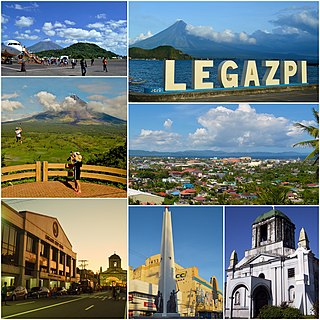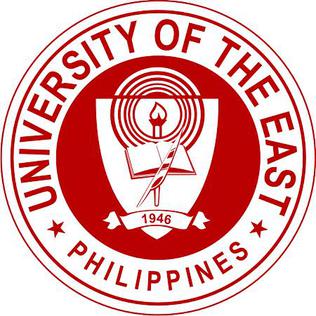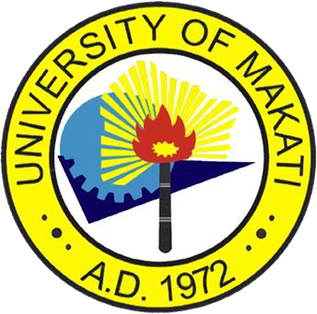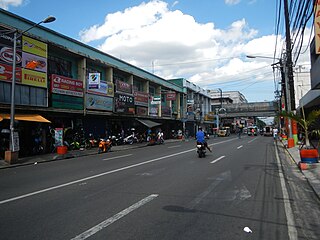
Metropolitan Manila, commonly shortened to Metro Manila and formally the National Capital Region, is the capital region and largest metropolitan area of the Philippines. Located on the eastern shore of Manila Bay, the region lies between the Central Luzon and Calabarzon regions. Encompassing an area of 636.00 km2 (245.56 sq mi) and with a population of 13,484,462 as of 2020, it is composed of sixteen highly urbanized cities: the capital city, Manila, Caloocan, Las Piñas, Makati, Malabon, Mandaluyong, Marikina, Muntinlupa, Navotas, Parañaque, Pasay, Pasig, Quezon City, San Juan, Taguig, and Valenzuela, along with one independent municipality, Pateros. As the second most populous and the most densely populated region in the Philippines, it ranks as the 9th most populous metropolitan area in Asia and the 6th most populous urban area in the world.

Quezon City, also known as the City of Quezon and Q.C., is the most populous city in the Philippines. According to the 2020 census, it has a population of 2,960,048 people. It was founded on October 12, 1939, and was named after Manuel L. Quezon, the second president of the Philippines.

Ateneo de Manila University, commonly referred to as Ateneo de Manila or Ateneo, is a private, Catholic, teaching and research university, and a basic education institution located in Quezon City, Philippines. Established in 1859 by the Jesuits, it is among the oldest Jesuit-administered institutions of higher education in the Asia-Pacific.

Legazpi, officially the City of Legazpi, is a 1st class component city and capital of the province of Albay, Philippines. According to the 2020 census, it has a population of 209,533. Legazpi is the regional center and largest city of the Bicol Region and in Albay, in terms of population. It is the region's center of tourism, education, health services, commerce and transportation in the Bicol Region. The city is applying for a Highly Urbanized City (HUC).

Caloocan, officially the City of Caloocan, is a highly urbanized city in Metro Manila, Philippines. According to the 2020 census, it has a population of 1,661,584 people making it the fourth-most populous city in the Philippines.

Malabon, officially the City of Malabon, is a highly urbanized city in the National Capital Region of the Philippines. According to the 2020 census, it has a population of 380,522 people.

Lingayen, officially the Municipality of Lingayen, is a 1st class municipality and capital of the province of Pangasinan, Philippines. According to the 2020 census, it has a population of 107,728 people.

The University of the East, also known as UE, is a private university located in Manila, Philippines. Founded in 1946, business tycoon Lucio Tan acquired the university in 1990. UE was once labeled as the "largest university in Asia" when its enrollment in the past reached over 65,000 students.

The University of Caloocan City is a public-type local university established in 1971 and formerly called Caloocan City Community College and Caloocan City Polytechnic College. Its south campus is located at Biglang Awa Street, Grace Park East, 12th Avenue, Caloocan, Metro Manila, Philippines and the north campuses are Camarin Business Campus, Congressional Campus, and Bagong Silang Campus.
The Regional Science High School Union (RSHS-Union) is a specialized system of public secondary schools in the Philippines, established during the academic year 1994-1995. It is operated and supervised by the Department of Education, with a curriculum heavily focused on math and science. It remains within the ambit of the Department of Education, unlike the specialized science high school system of national scope, the Philippine Science High School.
Education in the Philippines is compulsory at the basic education level, composed of kindergarten, elementary school, junior high school, and senior high school. The educational system is managed by three government agencies by level of education: the Department of Education (DepEd) for basic education; the Commission on Higher Education (CHED) for higher education; and the Technical Education and Skills Development Authority (TESDA) for technical and vocational education. Public education is funded by the national government.

The University of the East, Caloocan Extension Campus is a private higher education institution in Caloocan, Philippines. It is one of the three campuses of the University of the East system. It is an autonomous unit headed by a chancellor, with the College of Business Administration, Arts and Sciences, Engineering, and Fine Arts. UE Caloocan is called Caloocan Campus to distinguish it from the Manila Campus on C.M. Recto Avenue.
Philippine Cultural College is a Chinese Filipino school with three campuses located in Manila, Caloocan and Quezon City, Metro Manila, Philippines, established on June 27, 1923 by the Philippine Chinese Educational Association. PCC is the oldest Chinese Filipino secondary school in the Philippines. It is a non-stock, non-profit, and non-sectarian co-educational education institution offering pre-school, and has a Level II re-accredited status from the Philippine Accrediting Association of Schools, Colleges and Universities (PAASCU) for its grade school and high school. Its programs emphasize in the English, Filipino, and Mandarin Chinese languages, Mathematics, Science, and Information Technology.

The University of Makati, commonly referred to as UMak, is a public, local city university located in West Rembo, Taguig, Metro Manila, Philippines. The university was founded in 1972 by the Makati municipal government as the Makati Polytechnic Community College by virtue of Municipal Resolution No. 242 Ordinance No. 64. The ownership of the university's land and buildings are currently disputed between the cities of Makati and Taguig following the Supreme Court ruling of the Makati–Taguig territorial dispute.

Caloocan station is a railway station located on the North Main Line in Caloocan, Metro Manila, Philippines. It is rebuilt from its original location, now situated adjacent to the Caloocan railway depot, near Samson Road.
Allen Dizon, is a Filipino actor, model and producer. A former member of the Viva Hot Men, Dizon has transitioned from his early years in daring roles to become an independent film actor and producer.
Bagong Silang or Barangay 176 was a barangay in Caloocan, Metro Manila, Philippines that existed from 1971 its division. Part of the city's Zone 15, it was known for being the most populous barangay in the Philippines, with a population of 261,729 according to the 2020 census, as well as the largest barangay in the country in terms of land area, measuring 574 hectares. Due to its large population, there were calls to divide it. Following a plebiscite on August 31, 2024, it was divided into six distinct barangays: 176-A, 176-B, 176-C, 176-D, 176-E, and 176-F, though the area is still informally referred to as Bagong Silang.

Glorieta Park, sometimes spelled Glorietta Park, is an urban park in Caloocan, northern Metro Manila, the Philippines. It is situated near the border of barangays 187 and 188 in the former Tala Estate in North Caloocan. The park is one of three city-owned parks in Caloocan under the management of the Caloocan Parks Administration Services, the others being the Buena Park and Sports Complex in South Caloocan and the Caloocan Amparo Nature Park in eastern Tala, North Caloocan.

10th Avenue, formerly known as Macario Asistio Sr. Avenue or simply Asistio Avenue, is an undivided four-lane street in Caloocan, Metro Manila, Philippines that stretches east–west, bisecting south Caloocan. Like most avenues in the Grace Park area, it crosses a grid system of numbered streets that run from north to south, with other numbered avenues running from east to west. 10th Avenue was formally renamed as "Asistio Avenue" prior to the reversion of its current name, owing to it being the tenth avenue running east–west from the city's border with Manila in the south. The former renaming was done in 1984 to honor the former mayor of Caloocan who served from 1962 to 1971 and the father of another Caloocan mayor Boy Asistio, but has since been disregarded and reverted.
















